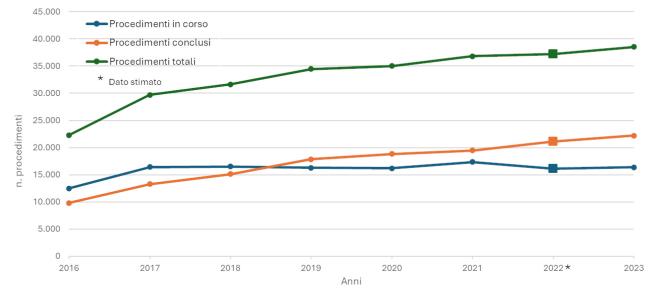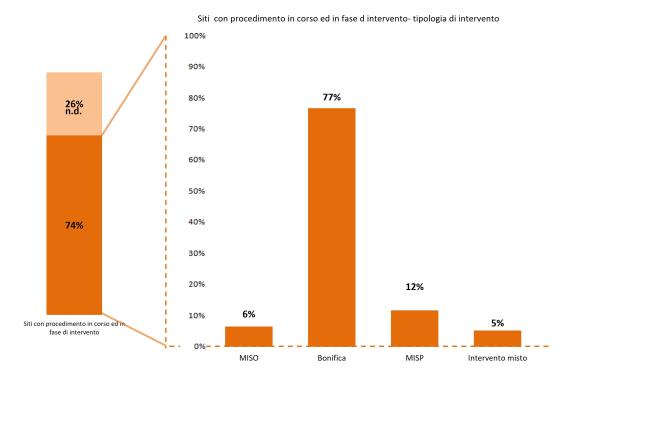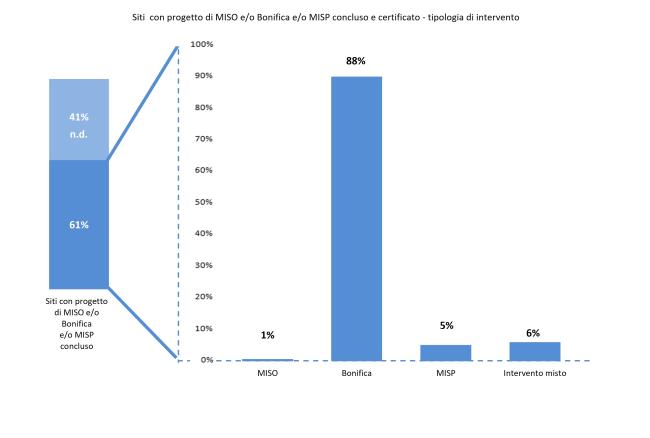Panel 1
Eugenia Bartolucci, Chiara Fiori, Luigi Marangio
The indicator provides information on sites subject to regional remediation procedures, based on data extracted from regional registries and databases. In 2023, 38,556 sites were registered, of which 22,191 have completed the remediation process.
For 62% of the sites, at least one surface area value (administrative or technical) is available. The sites for which the administrative area is known number 21,711, equal to 56% of the procedures. Among the ongoing procedures, 59% of the sites are in the notification phase, 21% are developing or have developed the conceptual model, while 20% have approved interventions.
For 97% of the sites with ongoing remediation procedures, the contamination status is known: 6,400 are potentially contaminated, 3,974 are contaminated, and 5,502 are awaiting analytical assessments. Among the concluded procedures, in only 30% of cases was an intervention necessary, while in the remaining 70% the procedure concluded without any intervention.
The indicator provides information on sites undergoing regional remediation procedures based on data extracted from the registries/databases of the regions/autonomous provinces/ARPA/APPA for the population of MOSAICO, the national information system on sites undergoing remediation procedures created by ISPRA within the framework of the National Environmental Protection System (SNPA) with the participation of Regions and Autonomous Provinces and managed by ISPRA. Procedures falling within Sites of National Interest (SIN) are excluded from the analysis and are represented by a specific indicator.
The indicator provides information on the number of sites registered in each registry/database, distinguishing those with ongoing procedures from those with concluded procedures, on the progress of procedure management, on how procedures concluded (with or without remediation), on the surface areas involved, on the contamination status, and on the types of intervention adopted (remediation, permanent safety measures - MISP, operational safety measures - MISO, mixed intervention).
Progress in the management of sites with ongoing remediation procedures is represented according to three phases: notification, conceptual model (characterization and any risk analysis), intervention including approved projects, ongoing interventions, and completed interventions awaiting certification or with partial certification.
Surface information has been provided as "administrative" and/or "technical" surface. The "administrative" surface refers to the entire area subject to administrative procedure (i.e., the sum of the involved cadastral parcels). The "technical" surface (equal to or smaller than the administrative surface) represents the area potentially impacted from an environmental perspective. The technical surface may vary, generally decrease, with the progress of the procedure due to improved knowledge.
Contamination status is categorized into four classes: sites awaiting assessment, potentially contaminated sites, contaminated sites, and non-contaminated sites. The first two relate to an ongoing "knowledge" phase; the "contaminated site" status indicates an actual and mandatory need for intervention, while non-contaminated sites are those found to be so either through investigation or following remediation.
To provide information on contaminated sites registered by the regions/autonomous provinces in their own registries/databases and, more generally, on sites undergoing remediation procedures, on the progress in their management, contamination status, and areas involved.
The management of contaminated sites is regulated in Italy by Legislative Decree 152/06 and subsequent amendments (Part IV, Title V). Legislative Decree 152/06 identifies risk analysis as the key tool for the definition and management of contaminated sites.
Article 251 of the Legislative Decree provides that regions and autonomous provinces shall prepare the registry of sites to be remediated, which must include a list of sites undergoing remediation and environmental restoration interventions, the identification of the responsible parties for the remediation, and the public entities that the region intends to use in case of default by the obligated parties, for the purpose of executing the remediation ex officio.
The current regulation sets conditions for the conclusion of the procedure, which in the case of contaminated sites consists of achieving the remediation objectives. However, it does not establish time limits for the achievement of specific procedural or remediation milestones.
Panel 2
2023, ISPRA. Lo stato delle bonifiche dei siti contaminati in Italia: secondo rapporto sui dati regionali. Rapporto 387/2023
2022, ISPRA, Ambiente in Italia: uno sguardo di insieme, Annuario dei dati ambientali 2022
2017, ISPRA. Annuario dei dati ambientali – Edizione 2017
Despite the constant updating of data, as of the reference date it is still not possible to provide a complete picture of the state of contamination and the progress of remediation efforts in Italy. Gaps persist due to the lack of integration and overlap of data related to procedures falling within Sites of National Interest (SIN) and those managed at the local level by the respective regions and autonomous provinces. Furthermore, the Sardinia region is not included in the analyses, as it has never contributed to the population of the MOSAICO system; the latest available data are outdated (updated as of 12/31/2019) and aggregated at the municipal level rather than by individual procedure.
In order to overcome these limitations and improve the quality of information, the following actions are necessary:
-
Acquisition of updated data for Sardinia: Integrating the missing information will make it possible to complete the overview of regional sites.
-
Extension of surface data: Collect data related to the administrative and technical extension of sites for procedures currently lacking this information.
-
Definition of contamination status: Determine the contamination status for procedures that are currently unclassified.
Data quality assessment
MOSAICO - SNPA Database of Sites Undergoing Remediation Procedures https://mosaicositicontaminati.isprambiente.it/index.html
National (I); Regional (R 19/20)
2016-2023
Indicator assessment
The progress in the management of sites undergoing procedures is expressed in terms of the number of sites found in each of the following three phases:
“Notification”: refers to the initial procedural phase consisting of the start of the process.
“Conceptual Model”: the conceptual model of the site is formulated, both in terms of verifying the presence and quantifying the contamination in environmental matrices, and in terms of defining the critical source-pathway-target routes on which to intervene in the possible remediation/operational safety (MISO)/permanent safety (MISP) phase.
“Remediation”: includes the procedural steps ranging from the approval of a remediation/MISO/MISP intervention to its conclusion pending certification.
The definition of the contamination status of the sites is divided into four possible scenarios:
-
In the sites in the notification phase, the contamination status is classified as “pending analytical verification”;
-
Following the execution of preliminary investigations and/or the characterization plan, the comparison with tabular screening values (CSC - contamination threshold concentrations) for soil and groundwater matrices leads to the identification of potentially contaminated sites (C>CSC – risk threshold concentrations); in some situations, especially for groundwater or in the case of applying simplified procedures, the exceeding of these tabular limits can lead to the designation of the site as contaminated;
-
Subsequently, through the site-specific risk analysis that establishes new threshold values (CSR), the site may be declared contaminated (C>CSR) or not contaminated (C<CSR);
-
Finally, a contaminated site is declared not contaminated following the positive conclusion of the intervention.
For the management of sites confirmed as contaminated, the legislation provides for the following interventions:
-
Operational safety (MISO): interventions carried out on a site with ongoing activity aimed at ensuring an adequate level of safety for people and the environment, pending further permanent safety or remediation interventions to be carried out upon the cessation of activity; it also includes contamination containment measures to be implemented temporarily until remediation or permanent safety is carried out, in order to prevent the spread of contamination within the same matrix or among different matrices;
-
Permanent safety (MISP): interventions aimed at definitively isolating the pollution sources from surrounding environmental matrices and ensuring a high and definitive level of safety for people and the environment; in such cases, monitoring and control plans must be provided, as well as use restrictions compared to urban planning instruments;
-
Remediation: interventions aimed at eliminating pollution sources and pollutants or at reducing their concentrations in soil, subsoil, and groundwater to a level equal to or lower than the risk threshold concentrations (CSR).
The areas affected by the procedures are indicated in hectares (ha) and are accompanied by the percentage of sites for which such information is available relative to the total number of registered sites.
The number of recorded procedures is 38,556, of which 16,365 are ongoing (equal to 42% of all procedures) and 22,191 are completed (58%) (Table 1).
A comparison between data updated to 2023 and those of 2021 shows an increase of 1,742 procedures in total (+5% compared to 2021), resulting from a decrease of 975 ongoing procedures and an increase of 2,717 completed procedures (Figure 1). The recorded changes depend on the initiation of new procedures during the 2022–2023 biennium, as well as on the verification and updating activities of the registries/databases carried out in the same period. Moreover, the absence of data from the Sardinia region may lead to an underestimation of the actual variation.
In fact, 2,593 procedures were initiated in the 2022–2023 biennium (Table 6), of which 1,082 were concluded in the same period.
The data relating to the number of procedures in 2022 (Figure 1) are estimated on the basis of information regarding the start and end dates of the procedures, updated to 2023.
The collection/transmission of data on regional remediation procedures has been increasing since the first year of indicator compilation (2016) (Figure 1).
The general trend (2016–2023) shows a significant increase in ongoing procedures from 2016 to 2017 (+31.7%), followed by stabilization with minor fluctuations. After the 2021 peak, a decrease is recorded in 2023 (-5.6%). Completed procedures, on the other hand, show a steady rise, especially between 2016 and 2017 (+35.4%). Although growth is less pronounced in subsequent years, a constant increase is still observed up to 2023 (+14% compared to 2021) (Figure 1).
As for total procedures, a more stable trend is observed compared to the other categories, with a steady and gradual increase until 2023 (+4.7% compared to 2021) (Figure 1).
From the annual data analysis, 2017 marks the greatest increase across all categories, suggesting a significant improvement in database compilation and verification activities. Completed procedures show a continuously growing trend, which is physiological within the context of remediation management and registry updates. Likewise, the trend toward stabilization of ongoing procedures may indicate improvements in the management of new cases.
Data
Figure 2: Number of sites subject to remediation procedures, ongoing and completed, and progress in the management of sites with ongoing procedures
ISPRA
-
Total sites with ongoing procedure
-
Total sites with completed procedure
-
Sites in the notification phase
-
Sites in the conceptual model phase
-
Sites in the intervention phase
Table 1: Sites subject to regional remediation procedures recorded in regional registries/databases
ISPRA processing based on data from SNPA, Regions and Autonomous Provinces
Update: 01/01/2024
Table 2: Surface area of sites subject to regional remediation procedures recorded in regional registries/databases
ISPRA processing based on data from SNPA, Regions, Autonomous Provinces
Update: 01/01/2024
Table 3: Progress in the management of sites with ongoing remediation procedures
ISPRA processing based on data from SNPA, Regions, Autonomous Provinces
Update: 01/01/2024
Table 4: Contamination status of sites subject to remediation procedures (ongoing and completed)
ISPRA processing based on data from SNPA, Regions, Autonomous Provinces
Update: 01/01/2024
Table 5: Sites with completed administrative remediation procedure, with or without intervention
ISPRA processing based on data from SNPA, Regions, Autonomous Provinces
Update: 01/01/2024
Table 6: New remediation procedures initiated in 2022 and 2023
ISPRA processing based on data from SNPA, Regions, Autonomous Provinces
Update: 01/01/2024



Information on the progress of the management of sites with remediation procedures is available for the entire national territory, except for the Sardinia region.
The number of sites registered in each regional registry/database does not remain constant but increases over time as new procedures are activated; in fact, sites with completed procedures remain listed in the registry/database. The total number of sites recorded in the regional registries/databases is composed of both ongoing and completed procedures.
The sites with ongoing administrative procedures recorded so far are mostly located in Lombardy (21%), Campania (19%), and Tuscany (13%). Similarly, completed procedures are mainly found in Lombardy (43%) and Tuscany (14%).
Regarding regional values, the highest percentages (greater than 70%) of sites with completed administrative procedures are found in the autonomous province of Bolzano (89%), the Aosta Valley (83%), Friuli-Venezia Giulia (83%), Lombardy (74%), and the autonomous province of Trento (76%).
Based on data updated as of 31/12/2023, 59% of procedures are in the notification phase, 21% in the conceptual model phase, and 20% in the intervention phase (Figure 2).
The highest regional percentages referring to the most advanced stage of the procedure — the so-called “sites in the intervention phase” — are observed in Lombardy (28%), Piedmont (12%), and Tuscany (11%) (Table 3).
The known administrative surface area involved in remediation procedures is 45,474 hectares, corresponding to 56% of the procedures. The technical surface area is 11,457 hectares and relates to 30% of the procedures. For 62% of the procedures, at least one surface data point (administrative or technical) is available (Table 2).
Looking at ongoing procedures, the administrative surface area amounts to 25,461 hectares and refers to 57% of the ongoing procedures, whereas the technical surface area is known only in 21% of these cases.
Regarding completed procedures, the percentage of sites for which administrative surface area is known is 56%, corresponding to 20,013 hectares; the technical surface area, amounting to 5,499 hectares, is known for 38% of the completed procedures.
The contamination status is defined for 97% of the sites with ongoing procedures and for 98% of those with completed procedures.
Of the total sites subject to remediation procedures, both ongoing and completed (38,556), 14.3% (5,502) are awaiting assessments, 16.6% (6,400) are potentially contaminated, 10.3% (3,974) are contaminated, while 56.3% (21,721) are not contaminated (Table 4); for the remaining 2.5% (959), information on the contamination status is not available.
Remediation procedures were completed without the need for intervention in 70% of the cases, and with intervention in 30% (Table 5).
The type of intervention adopted (remediation, MISP, MISO, mixed intervention) in sites with approved interventions and in those with completed interventions is shown in Figures 3 and 4, respectively.
Detailed information on the type of intervention is available for 74% of sites with ongoing procedures in the intervention phase (2,601), of which 77% involve remediation, 12% MISP, and 6% MISO (Figure 3).
In the case of sites with completed interventions (6,568), this detailed information is available for 61% of them, showing that in 88% of cases it is a remediation, in 5% MISP, and in 1% MISO (Figure 4).
In 2022, 1,288 procedures were initiated. The Lombardy region records the highest value with 678 procedures, while some regions did not report any new activations.
In 2023, the total was slightly higher, with 1,305 procedures initiated (Table 6).